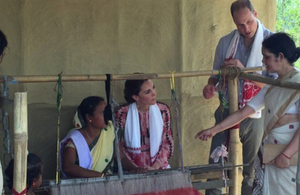The Duke and Duchess of Cambridge visit Kaziranga
The theme for Wednesday was firmly on the conservation efforts in Kaziranga National Park.

More than many other famous national parks in the world, in Kaziranga you get a real sense of how closely linked local people are to the animals that live there. This connection is not always easy. Wednesday’s events will allow The Duke and Duchess to see up close work being done to manage the conflicts that arise when humans and wild animals live in close proximity. A number of stories of human animal conflict in India have made global news recently and this trip will allow Their Royal Highnesses and accompanying media to understand this issue in much more detail.
The day began with an early start for an open-air drive around the National Park itself. The royal couple were welcomed by local people and park staff at the entrance to Kaziranga before the drive began. The Duke, President of United for Wildlife, has long wanted to visit Kaziranga. The park is situated on a flood plain and the vital annual floods drive animals up to the adjacent hills. In between the park and the hills, however, are growing numbers of villages which are in the path of ancient corridors for elephants and rhinos. The importance of the floods makes the area highly vulnerable to climate change as well, as reduced or increased snowmelts from the Himalayas could have severe consequences for this ecosystem.
The Duke and Duchess also met rangers inside Kaziranga. The park has had success in recent years with protecting its animal populations from poachers. This has begun to change, however, with a number of recent poaching incidents. Rhinos are in particular danger as demand in other parts of Asia for their horns continues to rise. Traffickers in South East Asia are now marketing Indian rhino horn as ‘fire horn’ and lying about its increased potency when compared to African horn. The Duke used this visit to speak out against the lies and violence that threaten this valuable species and the communities that rely on it.
Later in the morning, The Duke and Duchess visited a village on the edge of Kaziranga National Park. They met villagers in the community hall for a discussion about rural life in India, in a place where humans and animals live in close proximity. The Duke and Duchess met families and saw a variety of crops which provide their livelihoods, in addition to traditional crafts such as weaving.
In the afternoon, The Duke and Duchess visited the Centre for Wildlife Rehabilitation and Conservation. The centre provides emergency care and rehabilitation to wild animals that have been injured, displaced, or orphaned. The centre has a strong re-release rate of 60% and has rehabilitated thousands of animals including hand-raised elephants, rhinos, and bears. The centre is also home to rescued leopards which sadly cannot be re-released from the site and have to be rehomed in sanctuaries and zoos in other locations, mainly in India. Before leaving CWRC, The Duke and Duchess met young filmmakers who are members of Green Hub, a project that teaches film-making as a vocational skill to young people across North-East India. They saw two short films that both focus on human animal conflict.
After visiting CWRC, The Duke and Duchess travelled across the road to the Kaziranga Discovery Park built by Elephant Family, the charity founded by Mark Shand, late brother of The Duchess of Cornwall. Here they saw a first of its kind health clinic for working elephants and an elephant information centre, which is under construction. Their Royal Highnesses had an opportunity to meet with villagers who have been relocated by the charity to keep them safely out of the path of an elephant corridor.
Before departing, The Duke and Duchess put the finishing touches on an elephant sculpture to officially mark the ‘call for artists’ for India’s elephant parade, which will see 200 elephants decorated by artists and placed in 200 locations across India by the Elephant Family. These parades have previously been staged in London, Edinburgh, and New York.
Further information
Follow The Duke and Duchess of Cambridge’s visit to India and Bhutan on:
- Twitter @UKinIndia #RoyalVisitIndia
- Whatsapp: save the number +91-9654141882 to your contacts and send ‘hello’
For media queries, please contact:
Stuart Adam, Director,
Press and Communications
British High Commission,
Chanakyapuri, New Delhi 110021
Tel: 44192100; Fax: 24192411
Follow us on Twitter, Facebook, Flickr, YouTube, LinkedIn, Storify, Eventbrite, Blogs, Foursqare, Instagram, Vine, Snapchat @UKinIndia, Persicope @UKinIndia